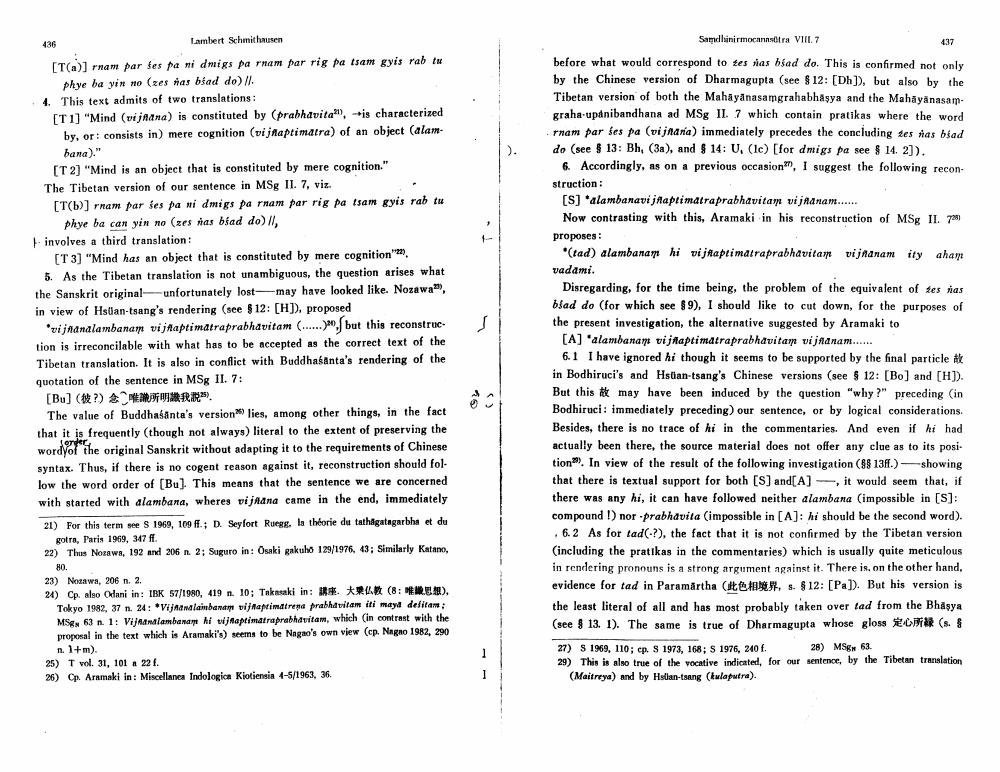Book Title: On Vinaptimatra Passage In Samadhinirmocanasutra VIII Author(s): L Schmithausen Publisher: L Schmithausen View full book textPage 3
________________ Lambert Schmithausen [T(a)] rnam par ses pa ni dmigs pa rnam par rig pa tsam gyis rab tu phye ba yin no (zes has bśad do) II. 4. This text admits of two translations: [T1] "Mind (vijnana) is constituted by (prabhavita", is characterized by, or consists in) mere cognition (vijnaptimatra) of an object (alambana)." 436 [T2] "Mind is an object that is constituted by mere cognition." The Tibetan version of our sentence in MSg II. 7, viz. [T(b)] rnam par les pa ni dmigs pa rnam par rig pa tsam gyis rab tu phye ba can yin no (zes nas blad do) II, involves a third translation: [T3] "Mind has an object that is constituted by mere cognition", 5. As the Tibetan translation is not unambiguous, the question arises what the Sanskrit original unfortunately lost-may have looked like. Nozawa, in view of Hsuan-tsang's rendering (see § 12: [H]), proposed 'vijnanalambanam vijñaptimatraprabhavitam (...), but this reconstruction is irreconcilable with what has to be accepted as the correct text of the Tibetan translation. It is also in conflict with Buddhaśanta's rendering of the quotation of the sentence in MSg II. 7: [Bu] (?) 唯所明謙説。 The value of Buddhasanta's version lies, among other things, in the fact that it is frequently (though not always) literal to the extent of preserving the Sonder wordyof the original Sanskrit without adapting it to the requirements of Chinese syntax. Thus, if there is no cogent reason against it, reconstruction should follow the word order of [Bu]. This means that the sentence we are concerned with started with alambana, wheres vijnana came in the end, immediately 21) For this term see S 1969, 109 ff.; D. Seyfort Ruegg, la théorie du tathagatagarbha et du gotra, Paris 1969, 347 ff. 22) Thus Nozawa, 192 and 206 n. 2; Suguro in: Osaki gakuho 129/1976, 43; Similarly Katano, 80. 23) Nozawa, 206 n. 2. 24) Cp. also Odani in: IBK 57/1980, 419 n. 10; Takasaki in: (8: M), Tokyo 1982, 37 n. 24: Vijnanalambanam vijnaptimatrena prabhavitam iti maya delitam; MSgs 63 n. 1: Vijnanalambanam hi vijnaptimatraprabhavitam, which (in contrast with the proposal in the text which is Aramaki's) seems to be Nagao's own view (cp. Nagno 1982, 290 n. 1+m). 25) T vol. 31, 101 a 22 f. 26) Cp. Aramaki in: Miscellanea Indologica Kiotiensia 4-5/1963, 36. J Samdhinirmocanas@tra VIII. 7 before what would correspond to tes as bad do. This is confirmed not only by the Chinese version of Dharmagupta (see $12: [Dh]), but also by the Tibetan version of both the Mahayanasamgrahabhasya and the Mahayanasam graha-upanibandhana ad MSg II. 7 which contain pratikas where the word rnam par ses pa (vijnana) immediately precedes the concluding tes nas biad do (see § 13: Bh, (3a), and § 14: U, (le) [for dmigs pa see § 14. 2]). 6. Accordingly, as on a previous occasion, I suggest the following recon 437 struction: [S] 'alambanavi jnaptimatraprabhavitam vijanam....... Now contrasting with this, Aramaki in his reconstruction of MSg II. 7 proposes: (tad) alambanam hi vijñaptimatraprabhavitam vijnanam ity aham vadami. Disregarding, for the time being, the problem of the equivalent of tes nas blad do (for which see §9), I should like to cut down, for the purposes of the present investigation, the alternative suggested by Aramaki to [A] *alambanam vijñaptimatraprabhavitam vijnanam....... 6.1 I have ignored hi though it seems to be supported by the final particle # in Bodhiruci's and Hstian-tsang's Chinese versions (see § 12: [Bo] and [H]). But this may have been induced by the question "why?" preceding (in Bodhiruci: immediately preceding) our sentence, or by logical considerations. Besides, there is no trace of hi in the commentaries. And even if hi had actually been there, the source material does not offer any clue as to its posi tion. In view of the result of the following investigation (88 13ff.)showing that there is textual support for both [S] and[A], it would seem that, if there was any hi, it can have followed neither alambana (impossible in [S]: compound!) nor -prabhavita (impossible in [A]: hi should be the second word). .6.2 As for tad(-?), the fact that it is not confirmed by the Tibetan version (including the pratikas in the commentaries) which is usually quite meticulous in rendering pronouns is a strong argument against it. There is, on the other hand, evidence for tad in Paramartha (t&, s. §12: [Pa]). But his version is the least literal of all and has most probably taken over tad from the Bhasya (see § 13. 1). The same is true of Dharmagupta whose gloss (s. 8 27) S 1969, 110; cp. S 1973, 168; S 1976, 240 f. 28) MS 63. 29) This is also true of the vocative indicated, for our sentence, by the Tibetan translation (Maitreya) and by Hsuan-tsang (kulaputra).Page Navigation
1 2 3 4 5 6 7 8 9 10 11 12
